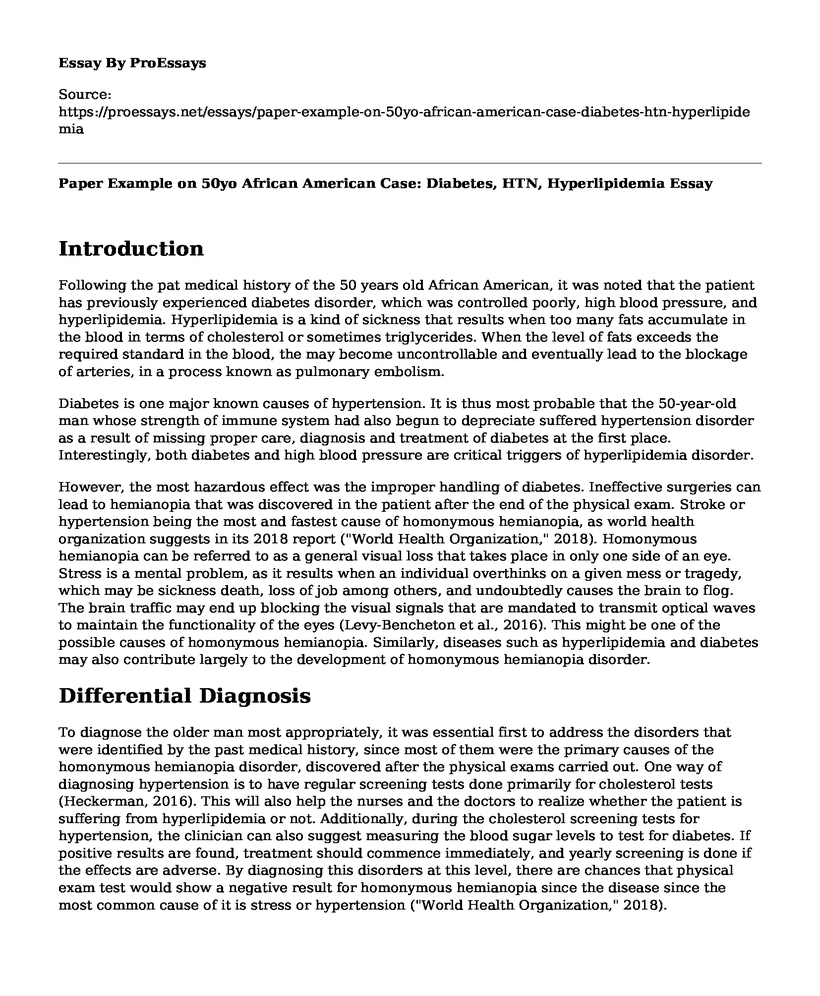Introduction
Following the pat medical history of the 50 years old African American, it was noted that the patient has previously experienced diabetes disorder, which was controlled poorly, high blood pressure, and hyperlipidemia. Hyperlipidemia is a kind of sickness that results when too many fats accumulate in the blood in terms of cholesterol or sometimes triglycerides. When the level of fats exceeds the required standard in the blood, the may become uncontrollable and eventually lead to the blockage of arteries, in a process known as pulmonary embolism.
Diabetes is one major known causes of hypertension. It is thus most probable that the 50-year-old man whose strength of immune system had also begun to depreciate suffered hypertension disorder as a result of missing proper care, diagnosis and treatment of diabetes at the first place. Interestingly, both diabetes and high blood pressure are critical triggers of hyperlipidemia disorder.
However, the most hazardous effect was the improper handling of diabetes. Ineffective surgeries can lead to hemianopia that was discovered in the patient after the end of the physical exam. Stroke or hypertension being the most and fastest cause of homonymous hemianopia, as world health organization suggests in its 2018 report ("World Health Organization," 2018). Homonymous hemianopia can be referred to as a general visual loss that takes place in only one side of an eye. Stress is a mental problem, as it results when an individual overthinks on a given mess or tragedy, which may be sickness death, loss of job among others, and undoubtedly causes the brain to flog. The brain traffic may end up blocking the visual signals that are mandated to transmit optical waves to maintain the functionality of the eyes (Levy-Bencheton et al., 2016). This might be one of the possible causes of homonymous hemianopia. Similarly, diseases such as hyperlipidemia and diabetes may also contribute largely to the development of homonymous hemianopia disorder.
Differential Diagnosis
To diagnose the older man most appropriately, it was essential first to address the disorders that were identified by the past medical history, since most of them were the primary causes of the homonymous hemianopia disorder, discovered after the physical exams carried out. One way of diagnosing hypertension is to have regular screening tests done primarily for cholesterol tests (Heckerman, 2016). This will also help the nurses and the doctors to realize whether the patient is suffering from hyperlipidemia or not. Additionally, during the cholesterol screening tests for hypertension, the clinician can also suggest measuring the blood sugar levels to test for diabetes. If positive results are found, treatment should commence immediately, and yearly screening is done if the effects are adverse. By diagnosing this disorders at this level, there are chances that physical exam test would show a negative result for homonymous hemianopia since the disease since the most common cause of it is stress or hypertension ("World Health Organization," 2018).
Treatment Plans
Based on the possible diagnosis techniques for the patient, the doctor can use Glipizide drug against diabetes, but ensure that the old male patient takes medicine before taking large or heavy meals as it aids the process of insulin secretion (Heckerman, 2016). The treatment against diabetes may reduce the effects of high blood pressure. However, the patient can take thiazide diuretics drugs for gradual but complete treatment of hypertension (De Boer et al., 2017). Having treated the two disorders, the effects of cholesterol or triglyceride accumulation will be reduced. This will also ensure that all the mental stress that indirectly leads to blockage of the visual signals is prevented.
References
De Boer, I. H., Bangalore, S., Benetos, A., Davis, A. M., Michos, E. D., Muntner, P. ... & Bakris, G. (2017). Diabetes and hypertension: a position statement by the American Diabetes Association. Diabetes Care, 40(9), 1273-1284. Retrieved from https://care.diabetesjournals.org/content/40/9/1273.abstract
World Health Organization. (2018). Report of the World Health Organization (WHO) biosafety inspection team of the variola virus maximum containment laboratories to the Centers for Disease Control and Prevention (CDC), Atlanta, Georgia, United States of America, 8-12 May 2017 (No. WHO/WHE/CPI/2018.15). World Health Organization. Retrieved from https://apps.who.int/iris/bitstream/handle/10665/272367/WHO-WHE-CPI-2018.15-eng.pdf
Heckerman, D. (2016). A tractable algorithm for diagnosing multiple diseases. Retrieved from https://www.microsoft.com/en-us/research/publication/tractable-algorithm-diagnosing-multiple-diseases/
Levy-Bencheton, D., Pelisson, D., Prost, M., Jacquin-Courtois, S., Salemme, R., Pisella, L., & Tilikete, C. (2016). The effects of short-lasting anti-saccade training in homonymous hemianopia with and without saccadic adaptation. Frontiers in behavioral neuroscience, 9, 332. Retrieved from https://www.frontiersin.org/articles/10.3389/fnbeh.2015.00332
Cite this page
Paper Example on 50yo African American Case: Diabetes, HTN, Hyperlipidemia. (2023, Jan 29). Retrieved from https://proessays.net/essays/paper-example-on-50yo-african-american-case-diabetes-htn-hyperlipidemia
If you are the original author of this essay and no longer wish to have it published on the ProEssays website, please click below to request its removal:
- Questions and Answers Essay on Nursery and Healthcare
- Essay Sample on Effective Dissemination of Nursing Evidence: Evaluating Appropriate Methods
- U.S. Pharmaceutical Prices: Local vs. Foreign Sources of Drugs - Essay Sample
- Essay Sample on Stakeholder Management: Key to Successful Change Projects
- Essay Example on Depression & Anxiety: Different Conditions, Common Symptoms
- Paper Sample on ConnectiveRx: Enhancing Patient Support Through Mergers & Acquisitions
- Planned Parenthood of Southeast Pennsylvania v Casey







